Grete Weixler (ca. 1900 - after 1922) was a German actress of the silent cinema. From 1914 on, she appeared in secondary roles in melodramas by directors like Carl Boese, Friedrich Zelnik and Lupu Pick.
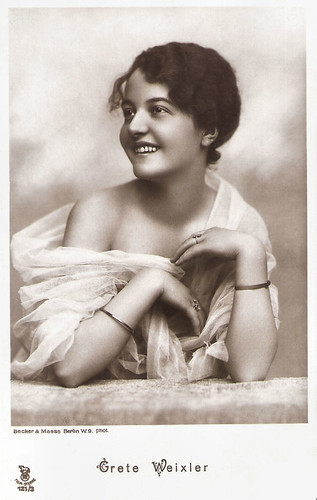
German postcard in the Film Sterne series by Rotophot, no. 121/3. Photo: Becker & Maass, Berlin.
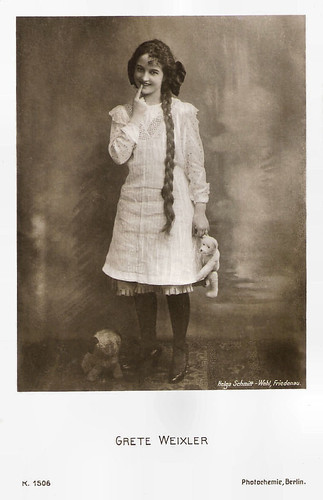
German postcard in Photochemie, Berlin, no. K 1324. Photo: Helga-Schmitt-Wehl, Friedenau.
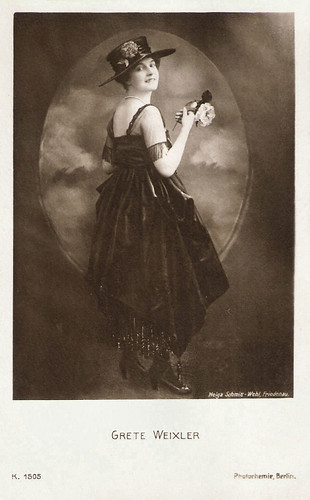
German postcard by Photochemie, Berlin, no. K 1505. Photo: Helga Schmitt-Wehl, Friedenau.
Grete Weixler was born into an actor’s family. Her grandfather had been successful in Hungary as an actor, Weixler's aunt lived as an artist in Vienna. Weixler's other siblings also turned to the performing arts.
Best known is her elder sister, popular silent film actress Dorrit Weixler. Grete followed in her footsteps and made her film debut under the direction of Dorrit’s husband, pioneer director Franz Hofer.
Possibly her first film was the silent short Fräulein Piccolo/Miss Piccolo (Franz Hofer, 1914) in which her sister starred and Ernst Lubitsch had a small role. Dorrit Weixler was the first German ‘backfish’, specialised in playing childlike young women in comedies.
In contrast to her sister, Grete Weixler appeared in serious films such as the melodramas Jahreszeiten des Lebens/Seasons of Life (Franz Hofer, 1915), Geopfert .../Sacrificed… (Walter Schmidthässler, 1916), and the Charles Dickens adaptation Klein Doortje/Little Dorrit (Friedrich Zelnik, 1917) featuring Lisa Weise.
Her next films included Margarete. Die Geschichte einer Gefallenen/Margarete. The story of a fallen woman (Friedrich Zelnik, 1918), featuring Lya Mara, and Verschleppt/Abducted (Carl Boese, 1919).

German postcard in the Film Sterne series by Rotophot, no. 121/1. Photo: Becker & Maass, Berlin.
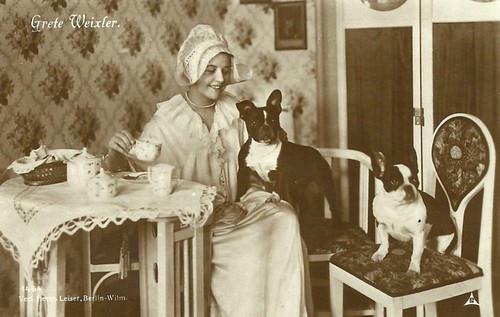
German postcard by Verlag Hermann Leiser, Berlin, no. 1464. Photo: Pm.
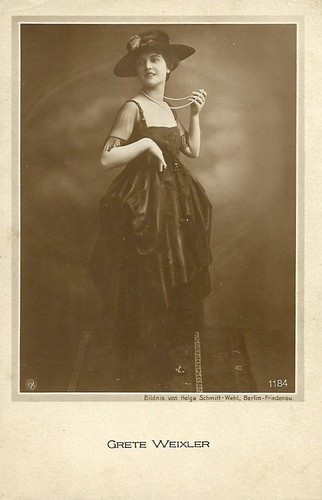
German postcard by NPG, no. 1184. Photo: Helga Schmidt-Wehl, Berlin-Friedenau.
In 1919, Grete Weixler took over the role of Lilly in Der Weg, der zur Verdammnis führt, 2. Teil. Hyänen der Lust (Otto Rippert, 1919) the second part of the film Der Weg der Verdammnis/The Way of Condemnation, about the fate of two young women who fall in the hands of girl traffickers.
Der Weg der Verdammnis/The Way of Condemnation was one of the most controversial and successful examples of the wave of ‘Sittenfilme’, melodramas about taboo subjects, mostly sexual, which were presented as enlightenment. This film was produced by the Gesellschaft zur Bekämpfung des Mädchenhandels (Society for the Struggle Against White Slavery).
Other films with Grete Weixler were Die Herrenschneiderin/The Lord's Cutler (Lupu Pick, 1919) and Die Sklavenhalter von Kansas-City/The Slaves of Kansas City (Wolfgang Neff, 1920) with a young Béla Lugosi.
In addition to her work in the cinema, Weixler was also a stage actress and appeared in the Trianon-Theater in Berlin. In 1922, she made her final film Die Tochter der Verführten/The Daughter of the seduced (Jaap Speyer, 1922) in which she played the daughter of a banker who falls for a femme fatale (Mia Pankau).
What happened to Grete Weixler after her retirement is not known. In 1916 her sister Dorrit, who was a morphine-dependent, had taken her own life.
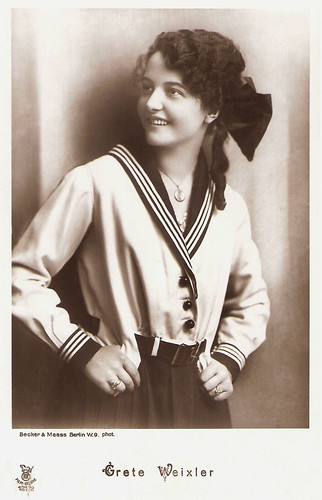
German postcard in the Film Sterne series by Rotophot, no. 121/2. Photo: Becker & Maass, Berlin.
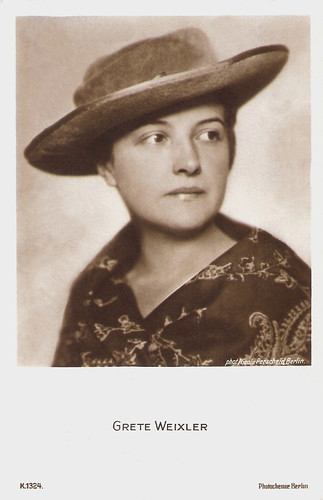
German postcard in Photochemie, Berlin, no. K 1324. Photo: Nicola Perscheid, Berlin.
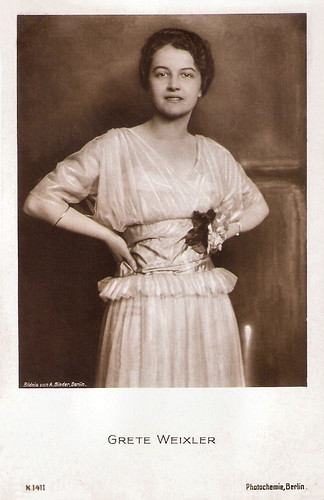
German postcard in Photochemie, Berlin, no. K 1411. Photo: Alex Binder, Berlin.
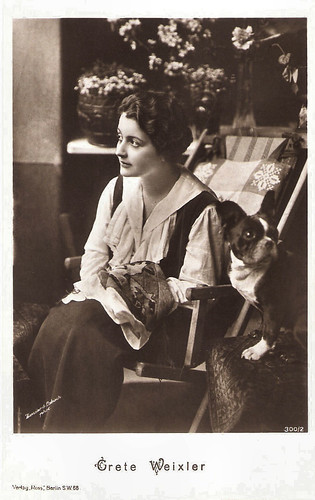
German postcard by Verlag Ross, Berlin, no. 300/2, 1919-1924. Photo: Zander and Labisch.
Sources: Stephanie D’heil (Steffi-Line), Sophie (German), Wikipedia (German) and IMDb.

German postcard in the Film Sterne series by Rotophot, no. 121/3. Photo: Becker & Maass, Berlin.

German postcard in Photochemie, Berlin, no. K 1324. Photo: Helga-Schmitt-Wehl, Friedenau.

German postcard by Photochemie, Berlin, no. K 1505. Photo: Helga Schmitt-Wehl, Friedenau.
The story of a fallen woman
Grete Weixler was born into an actor’s family. Her grandfather had been successful in Hungary as an actor, Weixler's aunt lived as an artist in Vienna. Weixler's other siblings also turned to the performing arts.
Best known is her elder sister, popular silent film actress Dorrit Weixler. Grete followed in her footsteps and made her film debut under the direction of Dorrit’s husband, pioneer director Franz Hofer.
Possibly her first film was the silent short Fräulein Piccolo/Miss Piccolo (Franz Hofer, 1914) in which her sister starred and Ernst Lubitsch had a small role. Dorrit Weixler was the first German ‘backfish’, specialised in playing childlike young women in comedies.
In contrast to her sister, Grete Weixler appeared in serious films such as the melodramas Jahreszeiten des Lebens/Seasons of Life (Franz Hofer, 1915), Geopfert .../Sacrificed… (Walter Schmidthässler, 1916), and the Charles Dickens adaptation Klein Doortje/Little Dorrit (Friedrich Zelnik, 1917) featuring Lisa Weise.
Her next films included Margarete. Die Geschichte einer Gefallenen/Margarete. The story of a fallen woman (Friedrich Zelnik, 1918), featuring Lya Mara, and Verschleppt/Abducted (Carl Boese, 1919).

German postcard in the Film Sterne series by Rotophot, no. 121/1. Photo: Becker & Maass, Berlin.

German postcard by Verlag Hermann Leiser, Berlin, no. 1464. Photo: Pm.

German postcard by NPG, no. 1184. Photo: Helga Schmidt-Wehl, Berlin-Friedenau.
The Way of Condemnation
In 1919, Grete Weixler took over the role of Lilly in Der Weg, der zur Verdammnis führt, 2. Teil. Hyänen der Lust (Otto Rippert, 1919) the second part of the film Der Weg der Verdammnis/The Way of Condemnation, about the fate of two young women who fall in the hands of girl traffickers.
Der Weg der Verdammnis/The Way of Condemnation was one of the most controversial and successful examples of the wave of ‘Sittenfilme’, melodramas about taboo subjects, mostly sexual, which were presented as enlightenment. This film was produced by the Gesellschaft zur Bekämpfung des Mädchenhandels (Society for the Struggle Against White Slavery).
Other films with Grete Weixler were Die Herrenschneiderin/The Lord's Cutler (Lupu Pick, 1919) and Die Sklavenhalter von Kansas-City/The Slaves of Kansas City (Wolfgang Neff, 1920) with a young Béla Lugosi.
In addition to her work in the cinema, Weixler was also a stage actress and appeared in the Trianon-Theater in Berlin. In 1922, she made her final film Die Tochter der Verführten/The Daughter of the seduced (Jaap Speyer, 1922) in which she played the daughter of a banker who falls for a femme fatale (Mia Pankau).
What happened to Grete Weixler after her retirement is not known. In 1916 her sister Dorrit, who was a morphine-dependent, had taken her own life.

German postcard in the Film Sterne series by Rotophot, no. 121/2. Photo: Becker & Maass, Berlin.

German postcard in Photochemie, Berlin, no. K 1324. Photo: Nicola Perscheid, Berlin.

German postcard in Photochemie, Berlin, no. K 1411. Photo: Alex Binder, Berlin.

German postcard by Verlag Ross, Berlin, no. 300/2, 1919-1924. Photo: Zander and Labisch.
Sources: Stephanie D’heil (Steffi-Line), Sophie (German), Wikipedia (German) and IMDb.
No comments:
Post a Comment